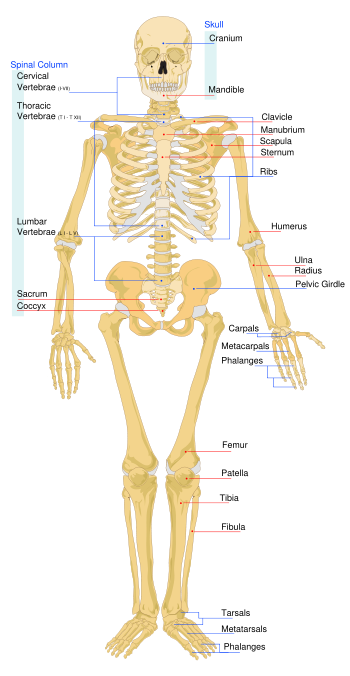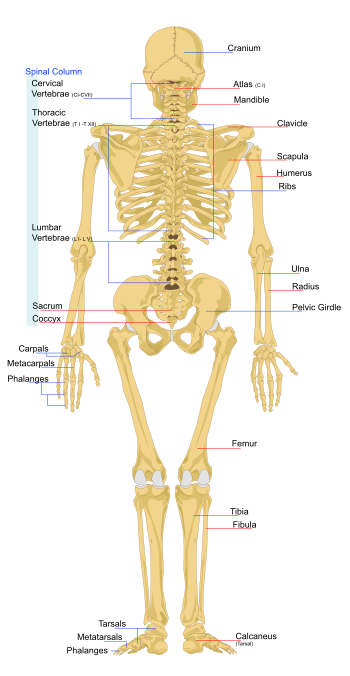
Front view of a skeleton of an adult human

Back view of a skeleton of an adult human
The human skeleton consists of both fused and individual bones supported and supplemented by ligaments, tendons, muscles and cartilage to serve as a rigid framework for the body. The skeleton supports organs, anchors muscles and facilitates movement (the muscles act upon the bones), and protects organs such as the brain, lungs and heart.
The average adult human skeleton has around 206 bones. These bones meet at joints, the most of which are freely movable. The skeleton also contains cartilage for elasticity. Ligaments are strong strips of fibrous connective tissue (sinew) that hold bones together at joints, thereby stabilizing the skeleton during movement. These differ from tendons, which connect muscle to bone. (Ligaments = bone + bone; tendons = muscle + bone)
Fused bones include those of the pelvis and the cranium.
The human skeleton can be broken up into two separate categories: the axial skeleton and the appendicular skeleton.[1] The axial skeleton is composed of the skull, vertebrae, and thoracic cage (ribs and sternum). The appendicular skeleton consists of the girdles (pelvic girdle and the pectoral girdle) and the skeleton of the limbs. [2]
Types of Bones[]
There are generally five categories of bones: long bones, short bones, flat bones, irregular bones, and sesamoid bones. [2] Long bones are longer than they are wide and work as levers. The bones of the upper and lower extremities (ex. humerus, tibia, femur, ulna, metacarpals, etc.) are of this type. Short bones are short, cube-shaped, and found in the wrists and ankles. Flat bones have broad surfaces for protection of organs and attachment of muscles (ex. ribs, cranial bones, bones of shoulder girdle). Irregular bones are all others that do not fall into the previous categories, with the exception of sesamoid bones (see below). Irregular bones have varied shapes, sizes, and surfaces features and include the bones of the vertebrae and a few in the skull.
- long bones - long bones are longer than they are wide (femur)
- short bones - short bones are shaped like cubes and are found primarily in the wrist and ankles
- flat bones - flat bones are thin, flat, and curved; they form the ribs, breastbone, and skull
- irregular bones - irregular bones are different shaped and are not classified as long, short, or flat; they include the hip bones, vertebrae, and various bones in the skull
- sesamoid bones - sesamoid bones are small round bony masses embedded in certain tendons that may be subjected to compression and tension; the largest sesamoid bone is the patella, which is embedded in the tendon of the quadriceps femoris at the knee
Joints[]
A joint is defined as the articulation between two or more bones.[3] Structurally, the joints are classified according to how the bones are connected to each other. There are three structural classifications of joints:
- fibrous joint - joined by fibrous connective tissue
- cartilaginous joint - joined by cartilage
- synovial joint - not directly joined
In addition to this, joints may be classified into three types by their degree of movement[4]:
- diarthroses - movable joints
- amphiarthroses - partially movable joints[5]
- synarthroses - immovable joints[6]
See Also[]
References[]
- ↑ various (n.d.). Divisions of the Skeletal System. Skeletal System.net. Retrieved on 2008-09-29.
- ↑ 2.0 2.1 various (n.d.). Skeletal System. Wikipedia. Retrieved on 2008-09-29. Cite error: Invalid
<ref>tag; name "WP" defined multiple times with different content - ↑ Donche, Dan (2008). FF Trainer Certification Guide. USA: Fatal Fitness.
- ↑ various (n.d.). Joints. Skeletal System.net. Retrieved on 2008-09-29.
- ↑ unk. (n.d.). Amphiarthroses. Virtual Medical Centre.com. Retrieved on 2008-09-29.
- ↑ unk. (n.d.). Articulations. Cancer.gov. Retrieved on 2008-09-29.